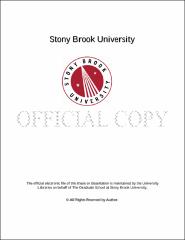| dc.identifier.uri | http://hdl.handle.net/11401/76904 | |
| dc.description.sponsorship | This work is sponsored by the Stony Brook University Graduate School in compliance with the requirements for completion of degree. | en_US |
| dc.format | Monograph | |
| dc.format.medium | Electronic Resource | en_US |
| dc.language.iso | en_US | |
| dc.publisher | The Graduate School, Stony Brook University: Stony Brook, NY. | |
| dc.type | Thesis | |
| dcterms.abstract | Protein O-fucosyltransferase 2 (POFUT2) elongates Thrombospondin Type 1 Repeats (TSR) with an O-linked fucose. Forty-nine potential proteins are modified by POFUT2 in the endoplasmic reticulum. Nearly half the POFUT2 targets belong to the A Disintegrin and Metalloprotease with ThromboSpondin type-1 motifs (ADAMTS) or ADAMTS-like family of proteins. One of POFUT2’s target proteins, ADAMTS9, contains 15 TSRs and is reported to be embryonic lethal around the same time as our Pofut2 LoxP mutants. In this study, we compared the Pofut2 and Adamts9 knockout phenotypes and used tissue specific deletion of Pofut2 to define the role of Pofut2 during gastrulation. Knockout of Pofut2 using either the LoxP or RST434 allele, as well as Adamts9 knockout resulted in a disorganized epithelia, compressed visceral and parietal endoderm, and reduction of mesoderm production during gastrulation. Adamts9 was expressed in the trophoblast giant cells, the parietal endoderm, a ring of proximal visceral endoderm near the ectoplacental cone, and the anterior primitive streak. To determine whether gastrulation defects in Pofut2 mutants resulted from abnormalities in the epiblast or from defects in the extra-embryonic tissues, we used Sox2::Cre to delete of Pofut2 in the epiblast. In contrast to the Pofut2 knockout, Sox2::Cre Pofut2 epiblast mutants formed mesoderm demonstrating the necessity of POFUT2 function in the extra-embryonic tissues for gastrulation. A shortened axis in the epiblast mutants implied a function of POFUT2 in the epiblast for axial elongation as well. Given the similarity between the Adamts9 and Pofut2 knockout phenotypes, and the expression of Adamts9 in the extra-embryonic tissues, we propose that the gastrulation defects in the Pofut2 knockout results from a defect in ADAMTS9 function in the trophoblast, parietal endoderm, or proximal visceral endoderm. Similarly, we propose that defects in axis elongation in the Pofut2 epiblast mutants could result from disruption of ADAMTS9 function in the anterior primitive streak. | |
| dcterms.abstract | Protein O-fucosyltransferase 2 (POFUT2) elongates Thrombospondin Type 1 Repeats (TSR) with an O-linked fucose. Forty-nine potential proteins are modified by POFUT2 in the endoplasmic reticulum. Nearly half the POFUT2 targets belong to the A Disintegrin and Metalloprotease with ThromboSpondin type-1 motifs (ADAMTS) or ADAMTS-like family of proteins. One of POFUT2’s target proteins, ADAMTS9, contains 15 TSRs and is reported to be embryonic lethal around the same time as our Pofut2 LoxP mutants. In this study, we compared the Pofut2 and Adamts9 knockout phenotypes and used tissue specific deletion of Pofut2 to define the role of Pofut2 during gastrulation. Knockout of Pofut2 using either the LoxP or RST434 allele, as well as Adamts9 knockout resulted in a disorganized epithelia, compressed visceral and parietal endoderm, and reduction of mesoderm production during gastrulation. Adamts9 was expressed in the trophoblast giant cells, the parietal endoderm, a ring of proximal visceral endoderm near the ectoplacental cone, and the anterior primitive streak. To determine whether gastrulation defects in Pofut2 mutants resulted from abnormalities in the epiblast or from defects in the extra-embryonic tissues, we used Sox2::Cre to delete of Pofut2 in the epiblast. In contrast to the Pofut2 knockout, Sox2::Cre Pofut2 epiblast mutants formed mesoderm demonstrating the necessity of POFUT2 function in the extra-embryonic tissues for gastrulation. A shortened axis in the epiblast mutants implied a function of POFUT2 in the epiblast for axial elongation as well. Given the similarity between the Adamts9 and Pofut2 knockout phenotypes, and the expression of Adamts9 in the extra-embryonic tissues, we propose that the gastrulation defects in the Pofut2 knockout results from a defect in ADAMTS9 function in the trophoblast, parietal endoderm, or proximal visceral endoderm. Similarly, we propose that defects in axis elongation in the Pofut2 epiblast mutants could result from disruption of ADAMTS9 function in the anterior primitive streak. | |
| dcterms.available | 2017-09-20T16:51:25Z | |
| dcterms.contributor | Holdener, Bernadette C | en_US |
| dcterms.contributor | Haltiwanger, Robert S | en_US |
| dcterms.creator | Benz, Brian | |
| dcterms.dateAccepted | 2017-09-20T16:51:25Z | |
| dcterms.dateSubmitted | 2017-09-20T16:51:25Z | |
| dcterms.description | Department of Biochemistry and Cell Biology. | en_US |
| dcterms.extent | 110 pg. | en_US |
| dcterms.format | Monograph | |
| dcterms.format | Application/PDF | en_US |
| dcterms.identifier | http://hdl.handle.net/11401/76904 | |
| dcterms.issued | 2015-12-01 | |
| dcterms.language | en_US | |
| dcterms.provenance | Made available in DSpace on 2017-09-20T16:51:25Z (GMT). No. of bitstreams: 1
Benz_grad.sunysb_0771M_12609.pdf: 1992691 bytes, checksum: 077b98d636717ac7e4b5cdd9fce2bf9e (MD5)
Previous issue date: 1 | en |
| dcterms.publisher | The Graduate School, Stony Brook University: Stony Brook, NY. | |
| dcterms.subject | Developmental biology | |
| dcterms.title | The role of POFUT2 in gastrulation and axis elongation of the mouse embryo | |
| dcterms.type | Thesis | |

